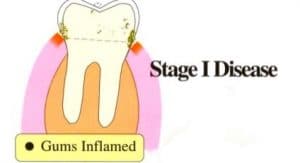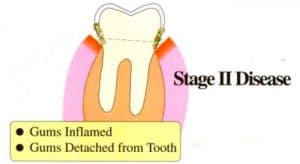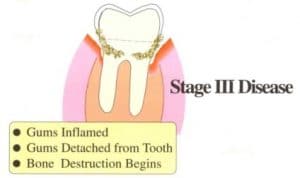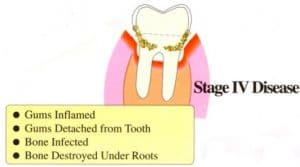Gum or periodontal disease
“Perio” means around and “dontal” refers to teeth. Periodontal diseases are bacterial infections that destroy the structures around the teeth which include the gums, periodontal ligament, and alveolar bone.
If left untreated, periodontal disease leads to tooth loss.
Causes
- Periodontal disease is caused by bacteria and calculus (tartar) that builds up under the gum line.
- The infection causes the gums to separate from the teeth forming “pockets” between the roots of the teeth and the gums.
- As the disease progresses, the pockets deepen as more gum tissue and bone are destroyed. Deep pockets provide an ideal environment for even more bacteria to colonize, making the disease even worse.
Risk factors
- Smoking one of the biggest risk factors of periodontal disease. Not only do the chemicals in tobacco have a harmful effect on your oral tissues, but it can deplete vitamin C and other nutrients and reduce your resistance periodontal disease.
- Genetics – some people are genetically susceptible to gum disease
- Hormone changes or imbalances such as those experienced during puberty, menopause, or pregnancy. 30-60% of pregnant women experience red, tender or bleeding gums.
- Stress – a contributing factor because it diminishes your body’s ability to fight infection.
- Systemic illnesses such as diabetes, HIV / AIDS, cancer
- Poor nutrition – especially a diet high in sugars and other sticky carbohydrates and low in the minerals and vitamins needed for healthy gums, teeth, and bones.
Symptoms
- There are various stages to periodontal disease – from gingivitis (early stage) to periodontitis (advanced disease). Red and swollen gums that bleed easily are a sign of gingivitis.
- You may notice bleeding when you brush, pus, swollen painful gums, bad breath or a bad taste in your mouth
- Gum recession or “longer” teeth
- Loose teeth that may shift in position
- Spaces between your teeth
- There often are no signs or symptoms of periodontal disease discernable to the patient; visiting your dentist regularly for a preventive checkup and professional cleaning is essential in preventing the progression of periodontal disease.
Diagnosis
- A dentist and/or hygienist will use a special probe to measure the depth of the pockets around your teeth. In a healthy mouth, the pockets are generally 3mm or less in depth and do not bleed when probed.
- X-rays can often reveal the amount of bone loss around your teeth.


When plaque and tartar build up around the teeth and are not removed in a timely fashion, gum disease begins. Plaque and tartar are full of billions of disease-causing bacteria that infect the gums causing gum inflammation or gingivitis. Inflamed gums are red, swollen and bleed easily. The good news is that Stage I gum disease is fully reversible.

If not removed, the plaque and tartar deposits on the roots continue to creep deeper under the gums, causing what is known as early periodontitis. This causes the gums to separate from the tooth, breaking the biologic seal. In Stage II, when the space between the gum and the tooth is measured, we get a reading of 4-5 millimeters.

As the plaque and tartar build-up progresses further down the root, the bacteria begin to infect and destroy the jaw bone supporting the tooth. Now, in what is called moderate periodontitis, when the space between the gum and the tooth is measured, we get a reading of 6-7 millimeters. Tooth mobility, root exposure, and moderate bone loss are characteristic of this stage. Bad breath or halitosis, may become noticeable at this time. Bone destruction and tartar can be seen on x-rays.

Bone destruction continues to progress in between the roots, the teeth begin to get even more loose or even shift, bad breath is common, and it may be difficult to chew. When the space between the gum and the tooth is measured, we get a reading of 8 millimeters or higher. This stage is known as advanced periodontitis.
Left untreated, gum disease will lead to eventual loosening and loss of the tooth.
Treatment
- The first step is referral by your regular dentist to a periodontist – a dentist specializing in the diagnosis, treatment, and prevention of gum disease. Dr. Jaclyn Glick is the periodontist at Cliffcrest Family Dental. She will perform a complete periodontal assessment and devise a treatment plan to address your specific needs
- Next, in most cases, scaling and root planing will be done, which is a careful cleaning of the root surfaces of teeth to remove plaque and calculus from the pockets. Local anesthetic (freezing) is often used to make this procedure more comfortable. It is important to remove all the plaque, bacteria, and stain in order to help the gum tissue become strong and firm.
- Several cleaning appointments often are needed for results to be seen.
- After a period of healing, Dr. Glick will re-evaluate your condition by re-measuring your pockets to see if there is any improvement.
- After scaling and root planing, many patients do not require any further active treatment and their condition can be maintained with regular professional cleanings every 3 months.
- In some cases, however, the pockets are too deep, and cannot effectively be cleaned or maintained in a state of health without surgery. In this event, Dr. Glick will discuss your treatment options with you.
Ongoing care
- Your oral hygiene at home is very important in controlling periodontal disease. In order for our treatment to be effective, you must continue to keep your teeth as clean as possible to prevent recurrence of the disease. It is also extremely important that you continue with regular professional cleanings so that we can continue to monitor your condition and maintain optimal oral health.
- Gum disease easily can return if you do not continue to take proper care of your teeth and gums. It is important to maintain your daily home care which should include brushing, flossing, and other techniques to remove the plaque and bacteria that naturally occur around your teeth.
- A t times, special mouth rinses or other oral cleaning aids may be recommended to help keep your teeth and gums healthy.
- Quitting smoking will drastically improve the prognosis of your teeth.
- Studies have shown that people with diabetes tend to have periodontal disease more often than those without diabetes and that often, the disease is more severe than that in other people. The good news, however, is that researchers also have found that some people with diabetes who receive treatment for periodontal disease seem improvements in their ability to control blood sugar levels after those treatments.
Your daily oral health routine and professional dental visits play vital roles in maintaining your overall health.

